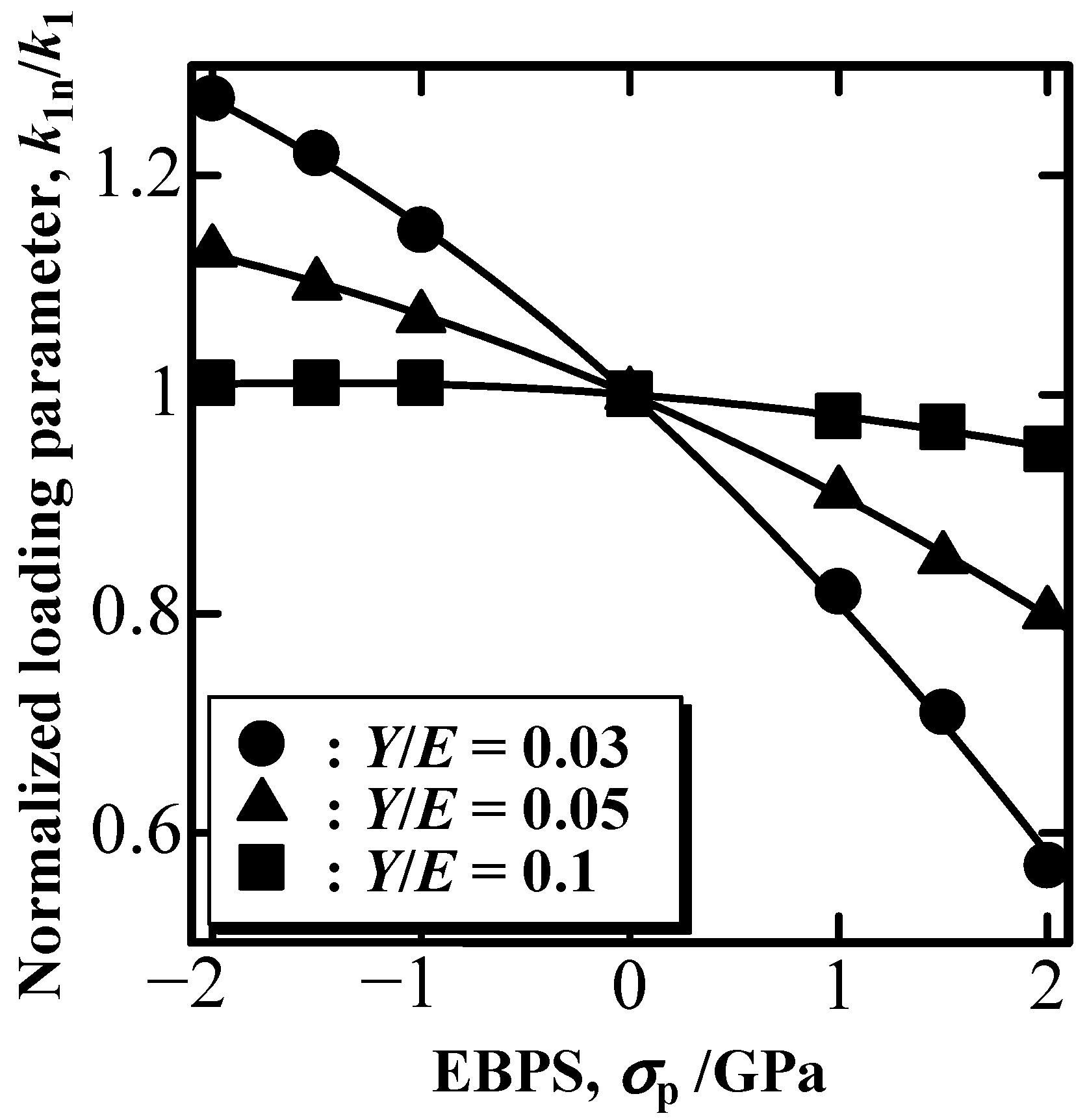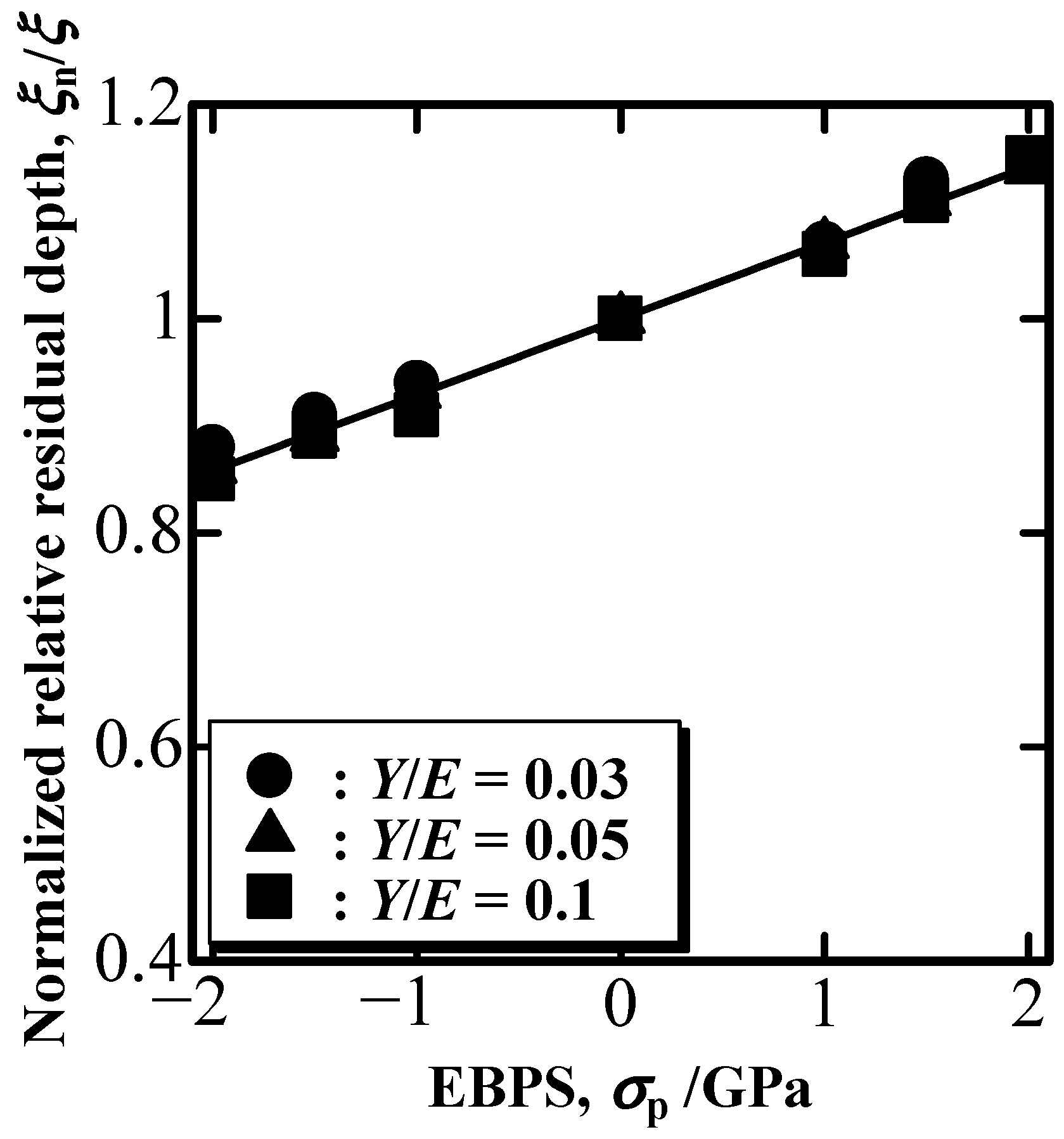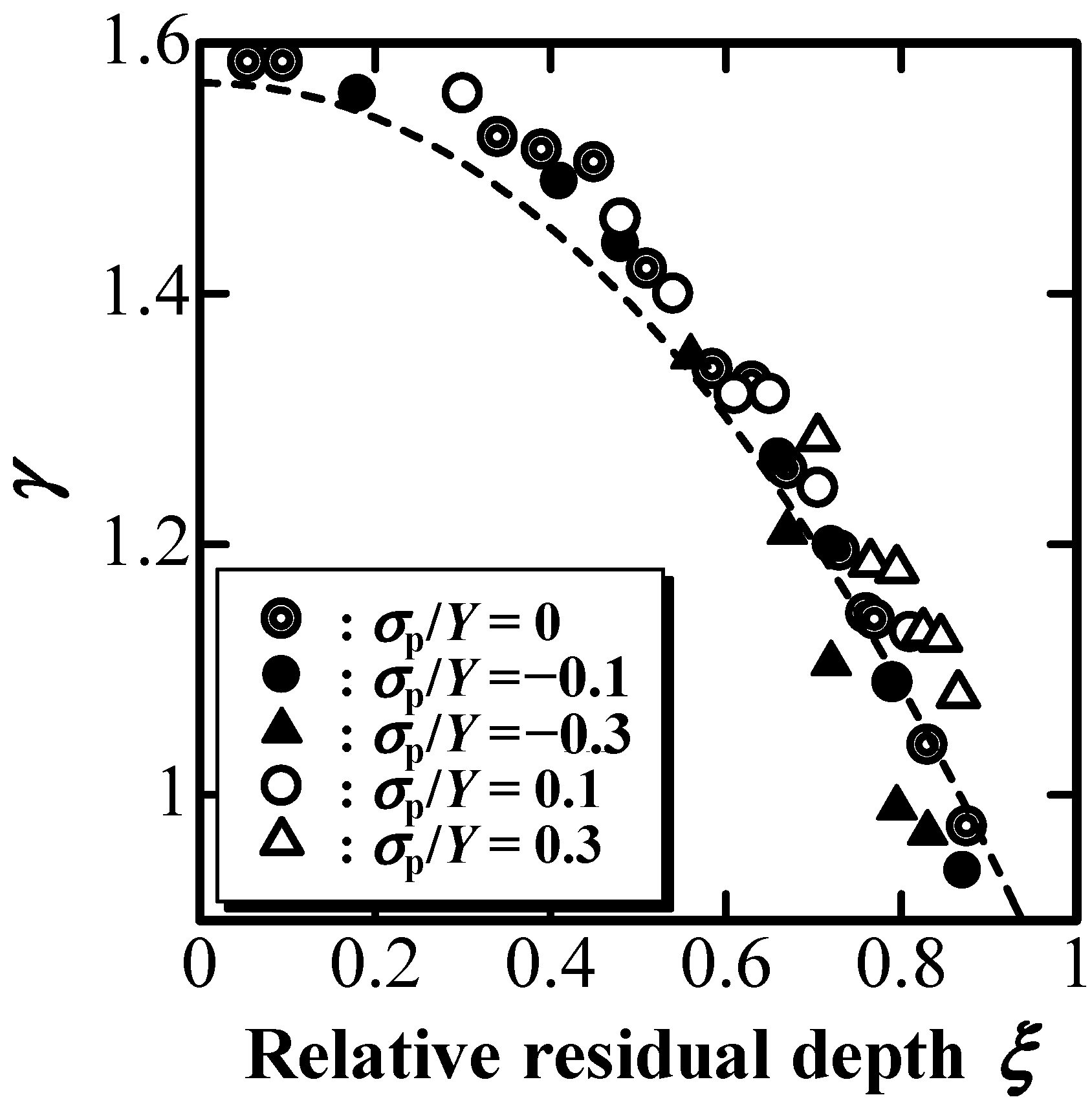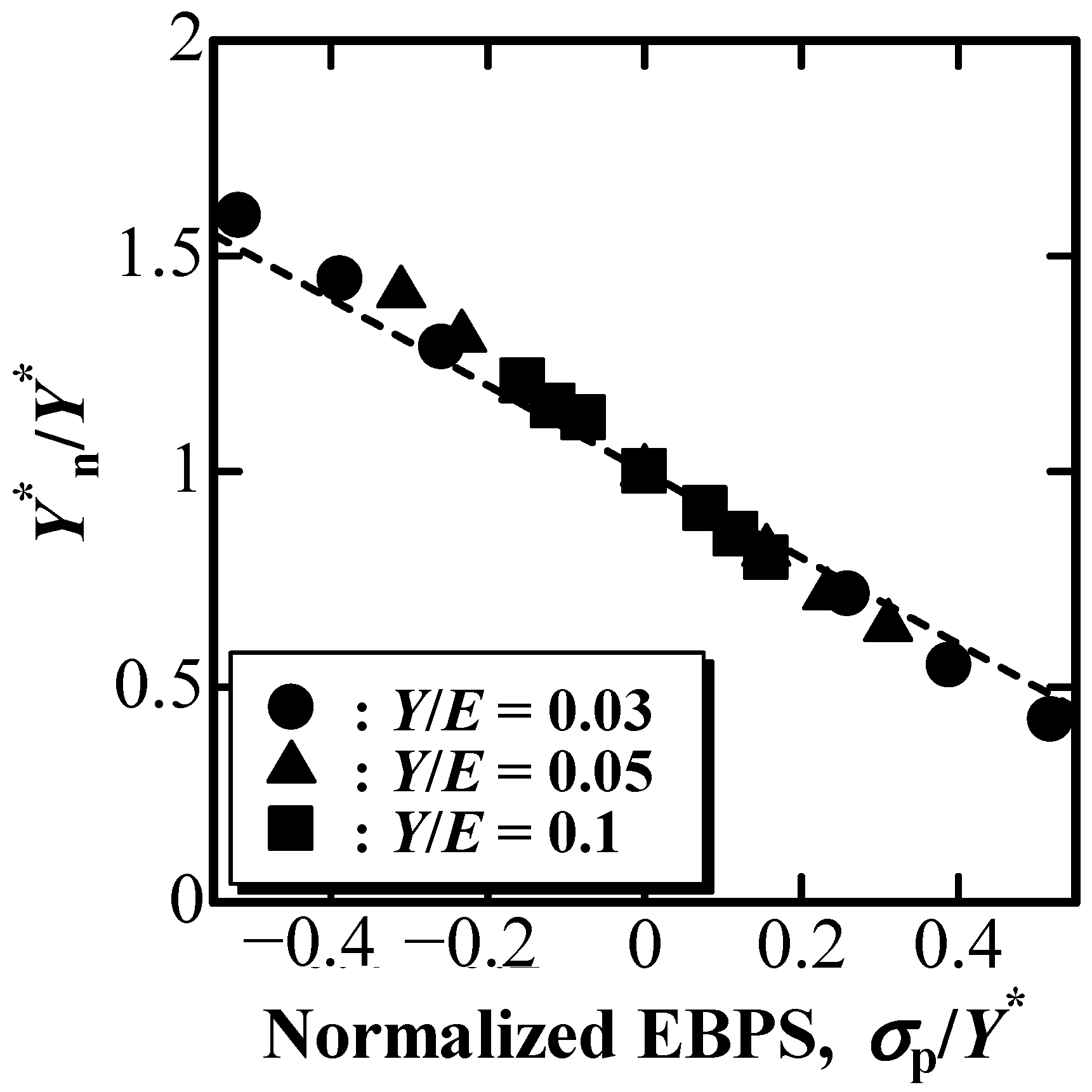Effect of Equibiaxial Pre-Stress on Mechanical Properties Evaluated Using Depth-Sensing Indentation with a Point-Sharp Indenter
Abstract
:1. Introduction
2. FEM Simulation of Indentation
3. Results
3.1. Effect of EBPS on a P–h Curve
3.2. Effect of EBPS on Piling-Up and Sinking-In around an Indentation
4. Discussion
4.1. Nominal Change in the Elastic Deformation Resistance E* Due to EBPS
4.2. Nominal Change in the Plastic Deformation Resistance Y* Due to EBPS
5. Conclusions
Author Contributions
Funding
Institutional Review Board Statement
Informed Consent Statement
Data Availability Statement
Conflicts of Interest
Appendix A. Estimation of E* and Y* for Thin Films/Coatings on a Substrate
References
- Doerner, M.F.; Nix, W.D. A method for interpreting the data from depth-sensing indentation instruments. J. Mater. Res. 1986, 1, 601–609. [Google Scholar] [CrossRef]
- Oliver, W.C.; Pharr, G.M. An improved technique for determining hardness and elastic modulus using load and displacement sensing indentation experiments. J. Mater. Res. 1992, 7, 1564–1583. [Google Scholar] [CrossRef]
- Anghel, C.R.; Ogasawara, N.; Chiba, N.; Che, X. Plastic properties identification of thin film utilizing substrate effect with conical indentation. Trans. Jpn. Soc. Mech. Eng. 2008, A74, 499–505. [Google Scholar] [CrossRef] [Green Version]
- Bull, S.J. Microstructure and indentation response of TiN coatings: The effect of measurement method. Thin Solid Films 2019, 688, 137452. [Google Scholar] [CrossRef]
- Burnett, P.J.; Rickerby, D.S. The relationship between hardness and scratch adhesion. Thin Solid Films 1987, 154, 403–416. [Google Scholar] [CrossRef]
- Cai, X.; Bangert, H. Hardness measurements of thin films-determining the critical ratio of depth to thickness using FEM. Thin Solid Films 1995, 264, 59–71. [Google Scholar] [CrossRef]
- Chen, J.; Bull, S.J. On the relationship between plastic zone radius and maximum depth during nanoindentation. Surf. Coat. Technol. 2006, 201, 4289–4293. [Google Scholar] [CrossRef]
- Fauvel, V.; Gaillard, Y.; Guillemet, R.; Garabédian, P.; Richard, F. Simultaneous extraction of the elastic-plastic properties of a thin film and its substrate from an identifiability-based design of depth-sensing nanoindentation testing. J. Mech. Phys. Solids 2022, 163, 104860. [Google Scholar] [CrossRef]
- Gao, H.; Chiu, C.-H.; Lee, J. Elastic contact versus indentation modeling of multi-layered materials. Int. J. Solids Struct. 1992, 29, 2471–2492. [Google Scholar] [CrossRef]
- Korsunsky, A.M.; McGurk, M.R.; Bull, S.J.; Page, T.F. On the hardness of coated systems. Surf. Coat. Technol. 1998, 99, 171–183. [Google Scholar] [CrossRef]
- Li, H.; Vlassak, J.J. Determining the elastic modulus and hardness of an ultra-thin film on a substrate using nanoindentation. J. Mater. Res. 2009, 24, 1114–1126. [Google Scholar] [CrossRef] [Green Version]
- Lichinchi, M.; Lenardi, C.; Haupt, J.; Vitali, R. Simulation of Berkovich nanoindentation experiments on thin films using finite element method. Thin Solid Films 1998, 312, 240–248. [Google Scholar] [CrossRef] [Green Version]
- Saha, R.; Nix, W.D. Effects of the substrate on the determination of thin film mechanical properties by nanoindentation. Acta Mater. 2002, 50, 23–38. [Google Scholar] [CrossRef]
- Sakai, M.; Zhang, J.; Matsuda, A. Elastic deformation of coating/substrate composites in axisymmetric indentation. J. Mater. Res. 2005, 20, 2173–2183. [Google Scholar] [CrossRef]
- Tsui, T.Y.; Pharr, G.M. Substrate effects on nanoindentation mechanical property measurement of soft films on hard substrates. J. Mater. Res. 1999, 14, 292–301. [Google Scholar] [CrossRef]
- Zak, S.; Trost, C.O.W.; Kreiml, P.; Cordill, M.J. Accurate measurement of thin film mechanical properties using nanoindentation. J. Mater. Res. 2022, 37, 1373–1389. [Google Scholar] [CrossRef]
- Hauk, V. Structural and Residual Stress Analysis by Non-Destructive Methods; Elsevier: New York, NY, USA, 1997. [Google Scholar]
- Lu, J.; James, M.R. (Eds.) Handbook of Measurement of Residual Stresses. Fairmount Press: Lilburn, GA, USA, 1996. [Google Scholar]
- Noyan, I.C.; Huang, T.C.; York, B.R. Residual stress/strain analysis in thin films by X-ray diffraction. Crit. Rev. Solid State Mater. Sci. 1995, 20, 125–177. [Google Scholar] [CrossRef]
- Bolshakov, A.; Oliver, W.C.; Pharr, G.M. Influences of stress on the measurement of mechanical properties using nanoindentation: Part II. Finite element simulations. J. Mater. Res. 1996, 11, 760–768. [Google Scholar] [CrossRef]
- Carlsson, S.; Larsson, P.-L. On the determination of residual stress and strain fields by sharp indentation testing.: Part I: Theoretical and numerical analysis. Acta Mater. 2001, 49, 2179–2191. [Google Scholar] [CrossRef]
- Carlsson, S.; Larsson, P.-L. On the determination of residual stress and strain fields by sharp indentation testing.: Part II: Experimental investigation. Acta Mater. 2001, 49, 2193–2203. [Google Scholar] [CrossRef]
- Jang, J.I. Estimation of residual stress by instrumented indentation: A review. J. Ceram. Process. Res. 2009, 10, 391–400. [Google Scholar]
- Suresh, S.; Giannakopoulos, A.E. A new method for estimating residual stresses by instrumented sharp indentation. Acta Mater. 1998, 46, 5755–5767. [Google Scholar] [CrossRef]
- Tsui, T.Y.; Oliver, W.C.; Pharr, G.M. Influences of stress on the measurement of mechanical properties using nanoindentation: Part I. Experimental studies in an aluminum alloy. J. Mater. Res. 1996, 11, 752–759. [Google Scholar] [CrossRef]
- Xu, Z.-H.; Li, X. Influence of equi-biaxial residual stress on unloading behaviour of nanoindentation. Acta Mater. 2005, 53, 1913–1919. [Google Scholar] [CrossRef]
- Xu, Z.-H.; Li, X. Estimation of residual stresses from elastic recovery of nanoindentation. Philos. Mag. 2006, 86, 2835–2846. [Google Scholar] [CrossRef]
- Buchheit, T.E.; Tandon, R. Measuring residual stress in glasses and ceramics using instrumented indentation. J. Mater. Res. 2007, 22, 2875–2887. [Google Scholar] [CrossRef]
- Chen, X.; Yan, J.; Karlsson, A.M. On the determination of residual stress and mechanical properties by indentation. Mater. Sci. Eng. 2006, A416, 139–149. [Google Scholar] [CrossRef] [Green Version]
- Liu, L.Z.; Bao, Y.W.; Zhou, Y.C. Effects of strain hardening and residual stress in impression on the instrumented indentation technique. J. Mater. Res. 2006, 21, 1680–1686. [Google Scholar] [CrossRef]
- Yan, J.; Karlsson, A.M.; Chen, X. Determining plastic properties of a material with residual stress by using conical indentation. Int. J. Solids Struct. 2007, 44, 3720–3737. [Google Scholar] [CrossRef] [Green Version]
- Zhao, M.; Chen, X.; Yan, J.; Karlsson, A.M. Determination of uniaxial residual stress and mechanical properties by instrumented indentation. Acta Mater. 2006, 54, 2823–2832. [Google Scholar] [CrossRef] [Green Version]
- Akatsu, T.; Numata, S.; Demura, T.; Shinoda, Y.; Wakai, F. Representative indentation elastic modulus evaluated by unloading of nanoindentation made with a point sharp indenter. Mech. Mater. 2015, 83, 66–71. [Google Scholar] [CrossRef]
- Akatsu, T.; Numata, S.; Demura, T.; Shinoda, Y.; Wakai, F. Representative indentation yield stress evaluated by behavior of nanoindentations made with a point sharp indenter. Mech. Mater. 2016, 92, 1–7. [Google Scholar] [CrossRef]
- Akatsu, T.; Numata, S.; Shinoda, Y.; Wakai, F. Effect of the elastic deformation of a point-sharp indenter on nanoindentation behavior. Materials 2017, 10, 270. [Google Scholar] [CrossRef] [PubMed] [Green Version]
- Zagrebelny, A.V.; Carter, C.B. Indentation of strained silicate-glass films on alumina substrates. Scripta Mater. 1997, 37, 1869–1875. [Google Scholar] [CrossRef]
- Johnson, K.L. Contact Mechanics; Cambridge University Press: Cambridge, UK, 1985. [Google Scholar]
- Sakai, M.; Nakano, Y. Elastoplastic load–depth hysteresis in pyramidal indentation. J. Mater. Res. 2002, 17, 2161–2173. [Google Scholar] [CrossRef]
- Tabor, D. Hardness of Metals; Clarendon Press: Oxford, UK, 1951. [Google Scholar]







Disclaimer/Publisher’s Note: The statements, opinions and data contained in all publications are solely those of the individual author(s) and contributor(s) and not of MDPI and/or the editor(s). MDPI and/or the editor(s) disclaim responsibility for any injury to people or property resulting from any ideas, methods, instructions or products referred to in the content. |
© 2023 by the authors. Licensee MDPI, Basel, Switzerland. This article is an open access article distributed under the terms and conditions of the Creative Commons Attribution (CC BY) license (https://creativecommons.org/licenses/by/4.0/).
Share and Cite
Akatsu, T.; Tabata, Y.; Shinoda, Y.; Wakai, F. Effect of Equibiaxial Pre-Stress on Mechanical Properties Evaluated Using Depth-Sensing Indentation with a Point-Sharp Indenter. Materials 2023, 16, 528. https://doi.org/10.3390/ma16020528
Akatsu T, Tabata Y, Shinoda Y, Wakai F. Effect of Equibiaxial Pre-Stress on Mechanical Properties Evaluated Using Depth-Sensing Indentation with a Point-Sharp Indenter. Materials. 2023; 16(2):528. https://doi.org/10.3390/ma16020528
Chicago/Turabian StyleAkatsu, Takashi, Yoshihide Tabata, Yutaka Shinoda, and Fumihiro Wakai. 2023. "Effect of Equibiaxial Pre-Stress on Mechanical Properties Evaluated Using Depth-Sensing Indentation with a Point-Sharp Indenter" Materials 16, no. 2: 528. https://doi.org/10.3390/ma16020528





